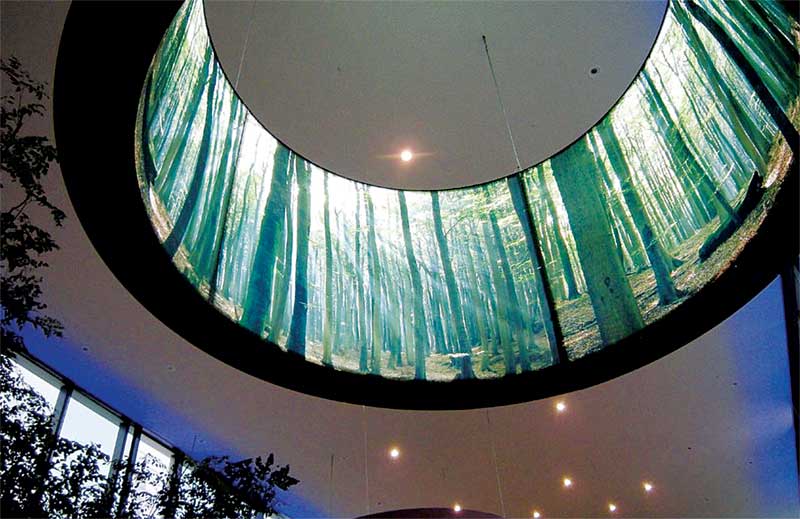Wide-format Printing: Selecting fabrics for backlit graphics
by all | 14 February 2018 12:17 pm
 [1]
[1]Photos courtesy TVF
By Mike Compton
Many print service providers (PSPs) are working with fabrics today for backlit graphics, while others are still seeking to learn about and enter this high-growth market. Mainstream applications include trade-show booths, museum exhibits, point-of-purchase (POP) retail displays, interior decor, storefronts, curved architectural structures, sports venue banners, airport ads and ceiling displays, among many others.
At the same time, there are many fabrics to choose from, with different weights and construction characteristics suitable for different applications.
Knitted vs. woven
One of the most basic choices is between knitted and woven fabrics.
Knitted fabrics typically offer better stretch characteristics for the frame systems for backlit graphics. They can even be easily used with curved frame structures. One of the advantages of their stretch capabilities is ensuring dimensional stability, as the stretching of printed graphics should be as uniform as possible.
Densely knitted fabrics provide stronger opacity for the diffusion of light-emitting diode (LED) illumination. Lock stitch construction prevents the accidental tearing of finished graphics and allows them to be cold-cut, rather than hot-knifed.
Woven fabrics can also be used for backlit graphic applications, depending on the density of the weave and, again, opacity and stretch capacity. They are best-suited for flat display frame structures, as they offer less stretching for curved frames.
These fabrics feature loose-end weave construction, so they require hot-knifing to seal their edges to prevent fraying. Depending on their precise type of weave, they may reveal ‘hot spots’ from LED illumination, particularly when finished images are viewed from an angle.
Both knitted and woven fabrics for backlit graphics range in weight from 113 to 312 g (4 to 11 oz) per 0.8 m2 (1 sq yd).
Coated vs. uncoated
Today’s premium fabrics that have been manufactured with backlit graphic applications in mind feature print-receptive diffuser coatings. By dispersing the light from the LEDs, these coatings help provide even illumination across the finished images.
Coatings prevent the aforementioned hot spots, which can be an issue with uncoated fabrics, and also eliminate ‘pinholes,’ where light could show through an open weave or knit and distract from the printed image’s quality. A properly coated fabric eliminates the need for an additional diffuser panel behind the graphic.
Coated fabrics are also recommended because they can be printed with a variety of inkjet technologies, including heat-transfer and direct dye sublimation, durable aqueous ‘latex’ and ultraviolet-curing (UV-curing) printers.
Extra attention may be needed when printing and handling coated fabrics, but the efforts pay off by yielding brilliant backlit graphics upon completion.
 [2]
[2]Different fabrics’ characteristics are suitable for different applications.
Silicone-edge graphics
Tension fabrics offer the necessary flexibility for sewing silicone-edge graphics (SEGs), which have become more common as equipment has improved and the market has grown.
An SEG is created by printing the fabric, sewing a thin silicone strip or gasket around its edges and then inserting the finished edges into a recessed groove all around the perimeter of a frame. This results in a ‘frameless’ edge-to-edge appearance.
Precise measurements are necessary for applying silicone edges to fabrics. If possible, it is best for the PSP to use a frame in-house, rather than outsource the process, as then a good, tight fit can be ensured in terms of both width and length.
The dimensional stretchability of the fabric is a key factor for success. There should be just enough ‘give’ in the material to allow the edge to be snapped into the frame. Too much stretch, on the other hand, can prevent the graphic from fitting properly, such that it sags and bunches along the edges and corners of the frame.
 [3]
[3]There are many ways to integrate backlit fabric graphics into the built environment.
Colour profiling
Since all fabrics are not created equal, it is essential to profile them properly for full-colour inkjet printing. Differences in white point from fabric to fabric—and even from batch to batch—will affect how printed, finished images appear. There can also be significant variances between coated and uncoated fabrics.
For rich, dark colours and brilliant, bright hues, it is best to use inks with a high density of colourants. This is especially true with dye sublimation, whether direct or via heat transfer.
Speaking of which, direct-disperse dye sublimation offers some of the best results on properly coated fabrics, due to the saturation of the inks into both the coatings and the fabric fibres. It is also important to understand how the type of frame and backlighting will affect the graphic’s appearance. Perimeter lighting is often the best choice for uniform illumination.
Indeed, printing systems, inks and finishing equipment all need to be colour-managed, so as to perform well together as a unit and produce superior fabric graphics.
Mike Compton is product marketing manager for Top Value Fabrics (TVF), which supplies textiles to the wide-format printing sector. This article is based on a seminar he presented in October at the 2017 Specialty Graphic Imaging Association (SGIA) Expo in New Orleans, La. For more information, visit www.tvfmedia.com[4] and www.sgia.org[5].
- [Image]: https://www.signmedia.ca/wp-content/uploads/2018/02/backlit_SGIA-e1518628126663.jpg
- [Image]: https://www.signmedia.ca/wp-content/uploads/2018/02/backlit_pacificcoast_2.jpg
- [Image]: https://www.signmedia.ca/wp-content/uploads/2018/02/backlit_Matrix-Curved_Architectural-Structures.jpg
- www.tvfmedia.com: http://www.tvfmedia.com
- www.sgia.org: http://www.sgia.org
Source URL: https://www.signmedia.ca/35113-2/